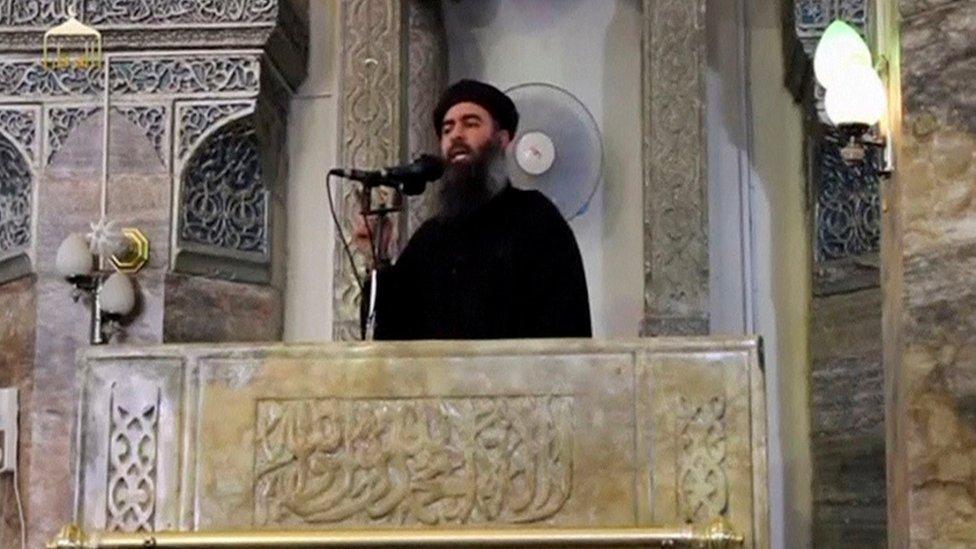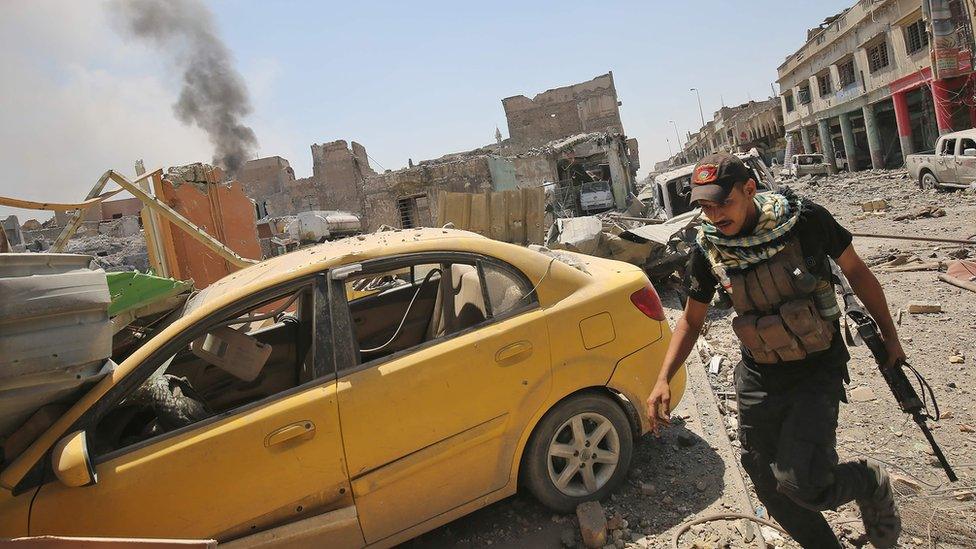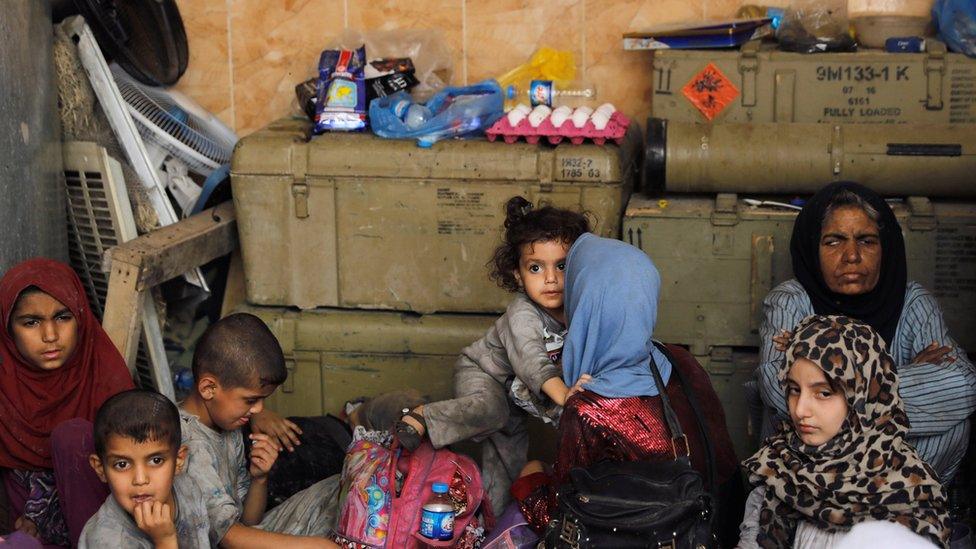Battle for Mosul: Ruins of Great Mosque of al-Nuri retaken
- Published
At the ruins of al-Nuri mosque
Iraqi security forces have recaptured the site of the destroyed Great Mosque of al-Nuri in Mosul after driving back militants from so-called Islamic State.
A BBC reporter who is embedded with troops says the complex is still exposed to sniper and mortar fire.
Militants blew up the mosque and its landmark leaning minaret last week.
Using a pejorative term for the jihadist group, Prime Minister Haider al-Abadi said, external retaking the site marked "the end of the fake Daesh state".
"We will not relent, our brave forces will bring victory," he added. "We will continue to fight Daesh until every last one of them is killed or brought to justice."
The mosque is of great symbolic importance to both sides because Abu Bakr al-Baghdadi made his only public appearance as IS leader there days after the jihadist group proclaimed the creation of a "caliphate" exactly three years ago.

Abu Bakr al-Baghdadi made his first public appearance as IS leader at the mosque in July 2014
The militants are now in retreat across Iraq and neighbouring Syria, where US-backed Kurdish and Arab fighters are laying siege to the city of Raqqa.
A coalition spokesman tweeted, external that some 84,000 sq km (32,000 sq miles) of territory had so far been retaken and more than four million people freed from IS rule, adding: "[IS's] so-called caliphate is crumbling; from outside and from within".
The research firm IHS Markit meanwhile estimated, external that the jihadists still controlled about 36,200 sq km (13,980 sq miles) across Iraq and Syria, and that their average monthly revenue had fallen dramatically, from $81m (£62m) in the second quarter of 2015 to $16m (£12m) in the second quarter of this year.

The Iraqi military says all but 1 sq km (0.4 sq miles) of Mosul has been retaken
Iraqi pro-government forces launched an offensive to retake Mosul in October with air and ground support from a US-led multinational coalition.
They managed to take full control of the eastern half of the city in January and started an assault on the west the following month.
Only a few hundred militants are now believed to be left in about 1 sq km (0.4 sq miles) of the Old City, along with some 50,000 civilians who humanitarian organisations say have little food or water and are at great risk of injury or death.

BBC Arabic's Feras Kilani says units from the Counter-Terrorism Service (CTS), Emergency Response Division (ERD), Federal Police and Iraqi Army began what they called the "final battle" for the Old City on Thursday.
The assault reportedly triggered clashes throughout the morning, with IS militants holding strong defensive positions, our correspondent adds.

Eyewitness: Sally Becker, aid worker
We have been ferrying some of the injured to our trauma stabilisation point.
There was a little girl with a head wound, whose father was killed by a sniper. Her little brother, who was about three years old, was telling me how he saw their father's body on the river bank.

More than 800,000 civilians have been displaced by the battle for Mosul
Later, we were sent into the "killing zone", as they call it, to pick up a woman with a suspected broken leg... She was with another 30 to 40 people, including many children. They were malnourished and dehydrated, and some of the children were clearly terrified.
I looked at one of the women and her eyes filled with tears. I was not sure if she was simply frightened or just incredibly relieved.
Sally Becker works for Road to Peace, external, an NGO helping children get access to medical treatment in war zones. She is currently working alongside Iraqi army medics to help treat the injured.

The overall commander of the offensive, Lt Gen Abdul Amir Yarallah, swiftly declared that CTS troops had taken control of what remained of the Nuri mosque, as well as the Sirjkhana district.
But it was not until several hours later that troops entered the mosque complex, our correspondent says.
The Great Mosque was named after Nur al-Din Mahmoud Zangi - famous for mobilising and unifying Muslim forces to wage jihad against the Christian Crusaders - who ordered its construction in 1172, shortly before his death.
Blast in Iraq destroys Great Mosque of al-Nuri
Despite its connection to such an illustrious figure, all that remained of the original mosque was its leaning minaret - nicknamed "al-Hadba", or "the humpback" - some columns and the mihrab, a niche indicating the direction of Mecca.
The Iraqi military said IS militants blew up the mosque and minaret eight days ago, leaving only the base of the minaret and a dome supported by a few pillars.
IS accused the US-led coalition aircraft of bombing the site, but experts said a video circulated online appeared to show charges inside the structures exploding.
In 2017 the BBC's Jonathan Beale spoke to RAF crews about the challenges they face in avoiding civilian casualties in Iraq and Syria